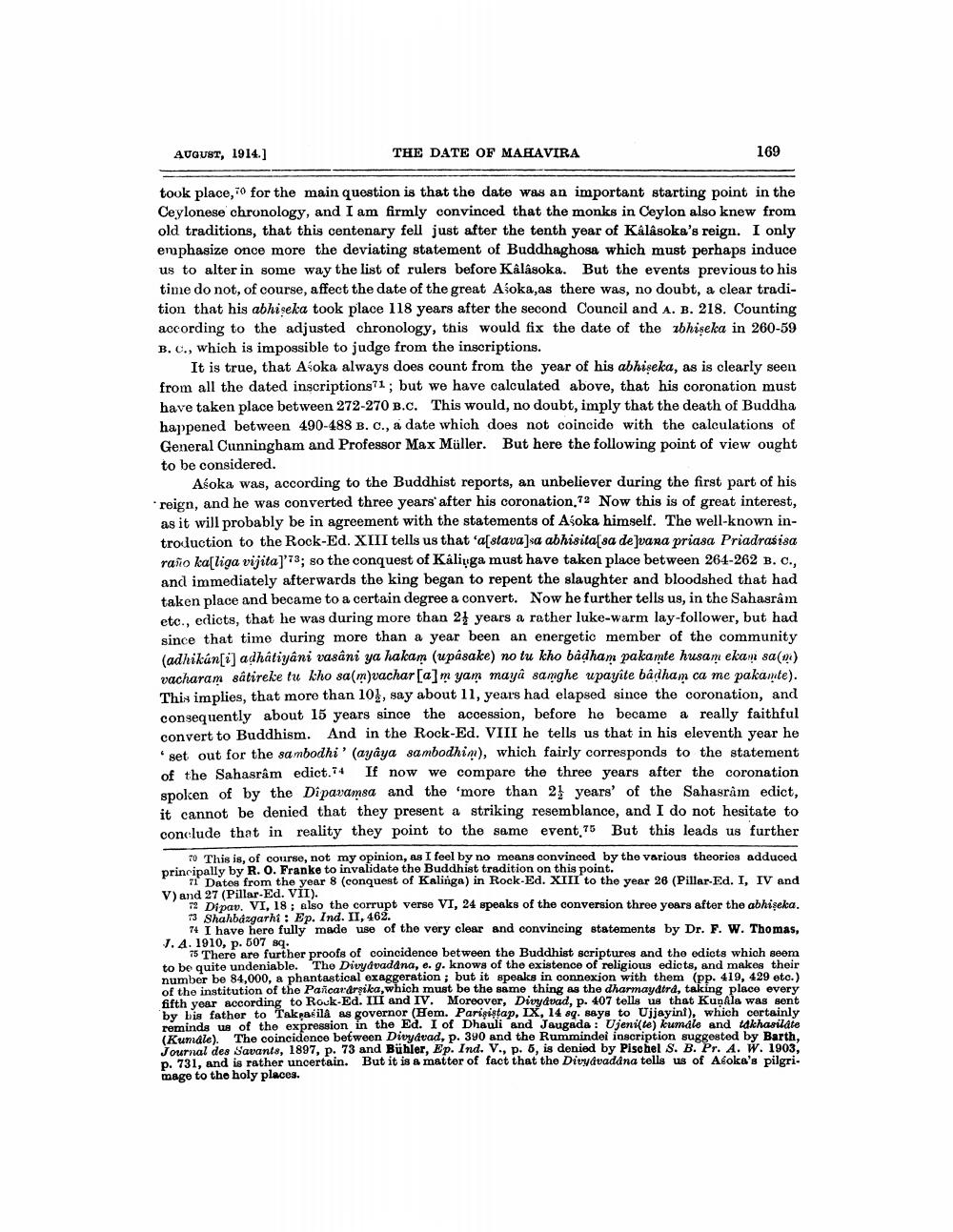________________
AUGUST, 1914.]
THE DATE OF MAHAVIRA
169
took place, 10 for the main question is that the date was an important starting point in the Ceylonese chronology, and I am firmly convinced that the monks in Ceylon also knew from old traditions, that this centenary fell just after the tenth year of Kálásoka's reign. I only emphasize once more the deviating statement of Buddhaghosa which must perhaps induce us to alter in some way the list of rulers before Kálásoka. But the events previous to his time do not, of course, affect the date of the great Asoka,as there was, no doubt, a clear tradition that his abhiseka took place 118 years after the second Council and A. B. 218. Counting according to the adjusted chronology, this would fix the date of the abhiseka in 260-59 B. c., which is impossible to judge from the inscriptions.
It is true, that Asoka always does count from the year of his abhiseka, as is clearly seen from all the dated inscriptions7i; but we have calculated above, that his coronation must have taken place between 272-270 B.C. This would, no doubt, imply that the death of Buddha happened between 490-488 B. C., a date which does not coincide with the calculations of General Cunningham and Professor Max Müller. But here the following point of view ought to be considered.
Asoka was, according to the Buddhist reports, an unbeliever during the first part of his · reign, and he was converted three years after his coronation.72 Now this is of great interest, as it will probably be in agreement with the statements of Asoka himself. The well-known introduction to the Rock-Ed. XIII tells us that 'a[stava]sa abhisita[sa de Juana priasa Priadrasisa raño ka[liga vijita]'73; so the conquest of Káliuga must have taken place between 264-262 B.C., and immediately afterwards the king began to repent the slaughter and bloodshed that had taken place and became to a certain degree a convert. Now he further tells us, in the Sahasrâm etc., edicts, that he was during more than 2 years a rather luke-warm lay-follower, but had since that time during more than a year been an energetic member of the community (adhikún[i] adhâtiyâni vasâni ya hakam (upásake) no tu kho badham pakamte husam ekam sa(0) vacharam sátireke tu kho sa(m)vachar[a]m yam maya samghe upayite badham ca me pakamte). This implies, that more than 10, say about 11, years had elapsed since the coronation, and consequently about 15 years since the accession, before he became a really faithful convert to Buddhism. And in the Rock-Ed. VIII he tells us that in his eleventh year he
set out for the sambodhi' (ayâya sambodhim), which fairly corresponds to the statement of the Sahasrâm edict.74 If now we compare the three years after the coronation spoken of by the Dipavamsa and the more than 21 years' of the Sahasram edict, it cannot be denied that they present a striking resemblance, and I do not hesitate to conclude that in reality they point to the same event 75 But this leads us further
70 This is, of course, not my opinion, as I feel by no means convinced by the various theories adduced principally by R. O. Franke to invalidate the Buddhist tradition on this point.
Ti Datos from the year 8 (conquest of Kalinga) in Rock-Ed. XIII to the year 26 (Pillar. Ed. I, IV and V) and 27 (Pillar-Ed. VII).
12 Dipav. VI, 18; also the corrupt verse VI, 24 speaks of the conversion three years after the abhişeka. 73 Shahbázgarhi : Ep. Ind. II, 462.
74 I have here fully made use of the very clear and convincing statements by Dr. F. W. Thomas, J.A. 1910, p. 507 sq.
75 There are further proofs of coincidence between the Buddhist scriptures and tho odicts which seem to be quite undeniable. Tho Divydvadana, e. g. knows of the existence of religious edicts, and makes their number be 84,000, a phantastical exaggeration; but it speaks in connexion with them (pp. 419, 429 etc.) of the institution of the Pancar drika, which must be the same thing as the dharmaydtrd, taking place every fifth year according to Rock-Ed. III and IV. Moreover, Divyavad, p. 407 tells us that Ku Ala was sent by his father to TakailA as governor (Hem. Parişistap, IX, 14 89. says to Ujjayint), which certainly reminds me of the expression in the Ed. I of Dhauli and Jaugada : Ujeni(te) kumdlo and khasilate (Kumale). The coincidence between Divyduad, p. 390 and the Rumminde inscription suggested by Barth. Journal des Savants, 1897, p. 73 and Bühler, Ep. Ind. V., p. 6, is denied by Pischel S. B. Pr. A. W. 1903, p. 731, and is rather uncertain. But it is a matter of fact that the Divydvadana tells us of Aloka's pilgri. mage to the holy places.




